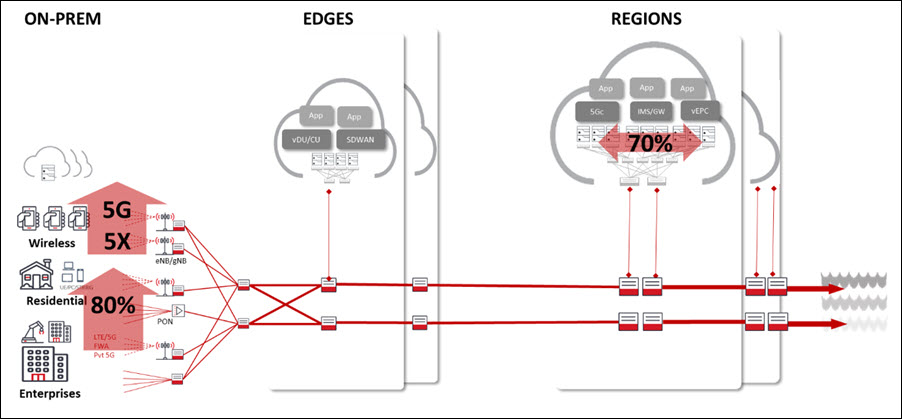3 key trends impacting the Edge and platformatization of networks
In the first of this two-part blog series, Ryan Perera, Vice President & Country Manager, Ciena India, explains the macro trends that will impact the distributed cloud computing world. This article was originally published on ET.Telecom.
The world today runs on a distributed cloud computing environment. Consumer workloads, enterprise workloads, and now telco’s internal network function workloads are being moved to the cloud. Public, private, or a combination thereof. The 2020 pandemic catalyzed some of these cloud-first transformations and enterprises are quickly discovering the optimal mix between the private and public multi-clouds. Given the proliferation of these hybrid multi-cloud environments, we are seeing emergence of end-to-end (E2E) application orchestrators such as Google Cloud Platform (GCP) Anthos, Microsoft Azure Arc, VMware Tanzu, and Red Hat OpenShift. Edge computing, which has received a lot of attention lately, is an important part of this distributed cloud computing environment.
Edge computing has been subjected to discussions because of its fluid definitions and lack of latency-sensitive killer applications. Edge is a natural extension of the core cloud. For end-users, edge clouds are subnets on their global Virtual Private Clouds (VPCs). So, it is no surprise to see public cloud giants making the most of this ‘cloud continuum’, by leveraging economies of scale, E2E orchestration portals, and Continuous Integration / Continuous Deployment (CI/CD) capabilities.
On the other hand, telcos have begun to partner with public cloud players to provide much-needed co-location and network connectivity, while providing their own managed enterprise services. AT&T, Verizon in the US, NTT in Asia, and DT and Telefónica in Europe are all announcing Edge deployments, mostly in partnership with public cloud providers. For example, AT&T has recently announced that it will be building 15 edges in partnership with Google in addition to its partnership with Microsoft Azure and IBM1.
- AT&T is also building out locations like stadiums, retail outlets, and manufacturing facilities with their edge offering 2
- Verizon plans to offer 20x Edge sites with both Public and Private offerings, in partnership with Amazon Web Services (AWS) and Microsoft Azure 3
- T-Mobile recently announced a deal with Lumen Technologies for edge computing services, across dozens of locations 4
On the telco cloud front – new entrants like DISH are using AWS for their internal network functions to support their 5G RAN and Core 5. However, most telcos around the world are building private clouds for their internal network workloads. Despite numerous discussions, the overall edge business opportunity remains difficult to define. However, as latency-sensitive applications gain more usage, there is a need to understand the economics of edge computing.
We see 3 key macro trends that will impact the distributed cloud computing world:
1. Advent of 5G
We will soon witness base stations housing multi-generational radios with multiple spectrum bands and up to 15-20 radios per macro tower. All these radios generating separate Common Public Radio Interface (CPRI) transport will become inefficient and expensive. This is driving packetization with enhanced CPRI (eCPRI) transport over standardized Ethernet networks. Furthermore, separate Base-Band Units (BBUs) for these multiple spectrum bands will be inefficient. Hence the drive towards various Centralized/Cloud-Radio Access Network (C-RAN) architectures, where baseband is being ‘centralized’ and then ‘virtualizing’ over-generalized server hardware.
To date, India has about 600,000 Base Transceiver Stations (BTS) and we estimate around 15-20% will be in some form of C-RAN over the next few years, predominantly Centralized Unit (CU) with midhaul transport. These initiatives can deliver significant economies of scale for telcos, considering close to 70% of a telco’s capital spent is tied to RAN. It’s estimated 5G will increase traffic in underlying connectivity networks by about five times.
2. Rise in residential networks demand
The hybrid work environment is placing heavy network connectivity requirements on the residential networks, resulting in 80% growth. SD-WAN, also referred to as Secure Access Service Edge (SASE) with added Security Service Edge (SSE), is emerging as a very powerful way to abstract multiple underlying heterogeneous networks. Whether wireline or wireless, SD-WAN can provide seamless E2E overlay networking with centralized Service Level Agreement (SLA) and policy control.
3. High traffic across data centers
Given the wide adoption of Artificial Intelligence (AI) and Machine Learning (ML) and the global nature of services from many businesses, the east-west traffic inside and across data centers is experiencing exponential growth.
In this backdrop, if you still believe in the premise that ‘the world will continue to run on a distributed cloud computing environment’, then someone needs to deliver on a connectivity network that is highly scalable, reliable, and promises low-latency.

Figure 1: This image represents the 3 key macro trends enlisted in this blog. In summary:
- 5G traffic will increase by 5X
- Network connectivity requirements on the residential networks have witnessed at least 80% growth recently
- Many cloud providers are experiencing a doubling of their AI/ML traffic workloads every 4-6 months
The same connectivity network architectures and business models are unlikely to survive in the coming years.
Public cloud providers have successfully mastered the art of delivering flexible consumption-based business models, leveraging cloud-native technologies such as - containerized micro-services and automation, to enable programmability and self-service, with “as-a-Service”, the new buzz word.
Now the question is … can the same principles be extended to the network?
Stay tuned for our next blog when we answer how telcos are changing their network strategy to adapt to an “as-a-Service” world.
**All views, opinions and data expressed here are solely by the author and for general information only. The views do not make representation or warranty of any kind, express or implied, regarding the accuracy, adequacy, validity, availability, reliability, or completeness of any information in this blog.
- https://about.att.com/story/2021/att_google_cloud.html, https://www.ntt.com/en/about-us/press-releases/news/article/2022/0118.html, https://www.telefonica.com/en/communication-room/telefonica-tech-partners-with-microsoft-to-provide-the-industrial-sector-with-private-5g-connectivity-and-on-premises-edge-computing/, https://www.businesswire.com/news/home/20210622005056/en/Mavenir-and-MobiledgeX-Enable-Global-Edge-Connectivity-With-Deutsche-Telekom
- https://www.business.att.com/products/att-network-edge.html
- https://www.verizon.com/about/news/verizon-private-mobile-edge-computing-enterprise-aws-outposts, https://www.verizon.com/about/news/verizon-debuts-cloud-computing-microsoft-azure
- https://www.t-mobile.com/news/business/t-mobile-lumen-new-choice-and-flexibility-for-enterprises












